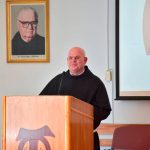From September 30 to October 1, 2022, the Roman Catholic Franciscan Theological Institute in Roman, Romania, hosted an international symposium with the theme: “The Later Rule of the Friars Minor: Eight Centuries of History, Challenge and Spirituality.”
This cultural event marked the opening of the Institute’s 2022-23 academic year. It also served as a prelude to the celebration of the 800th anniversary of the Later Rule of the Friars Minor, approved by Pope Honorius III on November 29, 1223, with his Papal Bull “Solet annuere.”
Because this is a Rule that continues to animate and invigorate the lives of the friars of the three Franciscan Orders, the opening speeches by the Rector of the Institute, and the Major Superiors present, underscored the importance of the Later Rule, which has become the path to holiness for so many generations of friars, and through them, has become accessible to all God’s people.
The symposium covered a variety of topics. There was a diversity of religious habits among the participants (OFM, OFM Conv., OFM Cap., and diocesan priests). The lecturers themselves came from different cultural backgrounds and represented several universities, such as, St. Edmund College in Cambridge, England; St. Bonaventure University in the State of New York, USA; Al. I. Cuza University in Iași, Romania; St. Thomas University in the State of Minnesota, USA; Babeș-Bolyai University in Cluj-Napoca, Romania; the Theological Institute in Assisi; the Pontifical University of St. Anthony (Antonianum) in Rome; and the Franciscan Theological Institute in Roman, Romania. All this diversity was intended to highlight the fact that, despite cultural, linguistic and ethnic differences, the Later Rule of the Friars Minor invites communion and offers a setting for fraternal life. The Later Rule is not life, because only the Word of God is life, but it gives form to the life expressed and manifested within it and the friars are its custodians and transmitters.
To better understand the Later Rule, the symposium began with an approach that highlighted the historical context, development and novelty that was prompted by St. Francis of Assisi through this new Rule. The symposium also examined Romania’s fertile Carpathian-Danubian-Pontic region where the Later Rule arrived with the friars in the 13th century, as well as the impact the Rule had on non-Christians, and later, on Protestant religions. The symposium continued with such topics as the role of the Holy Spirit in the life of the friars, the spiritual nature and the theological and juridical principles of the Later Rule and how, later, the Rule managed to survive between the sharp edge of the “sickle” and the blow of the “hammer” of the totalitarian regime in Romania.
The lectures during the symposium, and the topics they presented, were rewarding for both mind and heart.
Friar Ştefan ACATRINEI
























